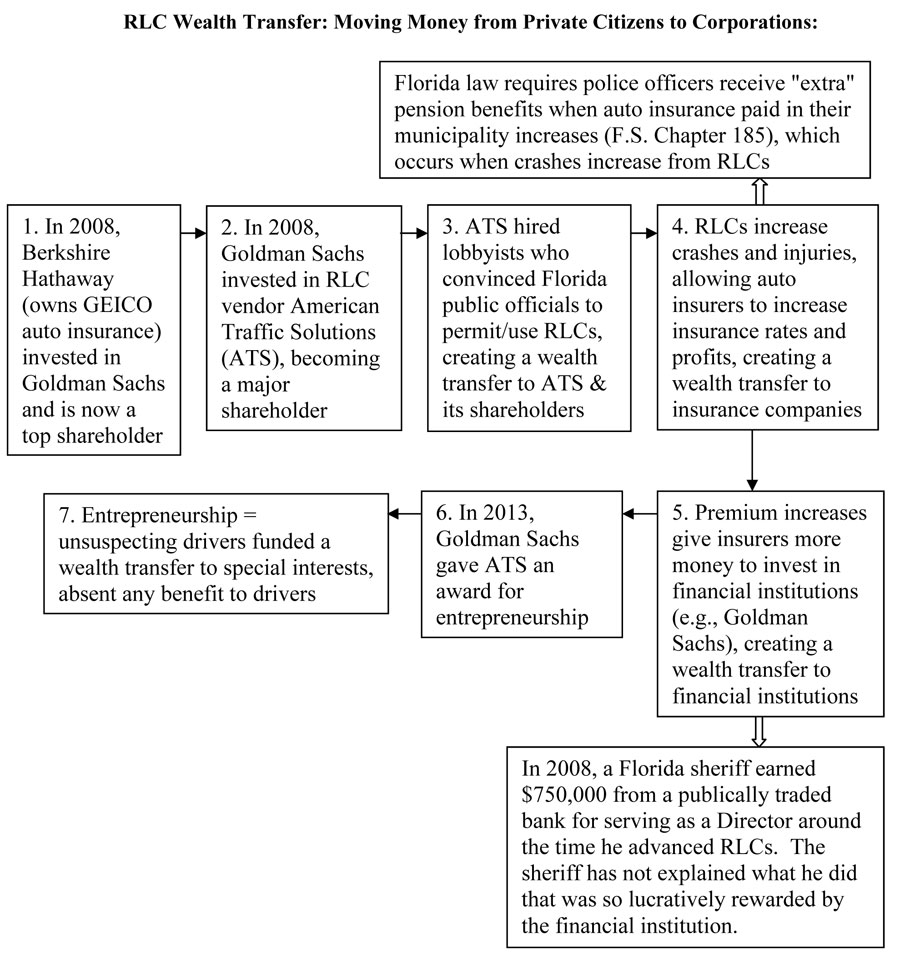Red Light Cameras
1. How much expense did Tampa’s red light camera (RLC) program create for drivers in its first year of operation?
In 2012, Tampa’s RLC program cost drivers $22 million, calculated as follows:
- $11 million for 69,700 RLC tickets
- $11 million for the auto insurance increase paid by Tampa drivers
Tampa officials admit to shorting the yellow light timings at RLC sites, which is done to increase tickets and revenues and is contrary to public safety. Average per capita auto insurance paid in Tampa has been decreasing since 2006, but increased in 2012 during the first year of RLC use, meaning insurance companies did not assume safety continued to improve in Tampa following RLC use.
|
Tampa Auto |
Per Capita |
|||
|
Year |
Insurance Paid |
% Change |
||
|
2006 |
$405,756,819 |
|||
|
2007 |
$390,206,232 |
-4.5% |
||
|
2008 |
$365,766,921 |
-7.7% |
||
|
2009 |
$365,767,813 |
-1.1% |
||
|
2010 |
$357,033,985 |
0.0% |
||
|
2011 |
$336,113,358 |
-8.8% |
||
|
2012 |
$347,799,986 |
3.1% |
1st Year of RLCs |
|
2. Why do RLCs not reduce red light running crashes?
RLCs are based on the surveillance strategy used to reduce driving under the influence (DUI). The public was informed that DUI enforcement increased and is continuous, which reduced DUI and related crashes since drivers do not want to be arrested. The success of this strategy depends on the targeted driving behavior (e.g., DUI) being intentional. All DUI is intentional since drivers know they are drinking and driving.
In contrast, red light running can be intentional or accidental. Intentional red light running typically occurs when drivers do not view cross traffic in the intersection, such as when the light is changing to red and hence perceive no risk of causing an accident. In contrast, it is necessary to have cross traffic in the intersection for a red light running crash to occur. As such, red light running crashes occur from accidental red light running when drivers cannot see or do not notice the red signal and enter the intersection, colliding with cross traffic.
RLCs are ineffective in reducing crashes since drivers do not intentionally run red lights when cross traffic is in the intersection and since RLCs do not reduce accidental red light running. Instead, RLCs are a detriment to safety since they encourage adverse driving behaviors in efforts to avoid a ticket, e.g., abrupt braking and accelerating into the intersection.
3. If RLCs are ineffective, why are they so heavily promoted?
RLCs are promoted by special interests since they create a wealth transfer from private citizens to powerful corporations, absent any benefit to citizens. An example of the RLC wealth transfer cycle is provided below.

4. What research provides evidence that RLCs are associated with increases in crashes and crash severity?
- The 2007 Empirical Bayes study from Virginia is the largest and best designed RLC study to date (funded by US DOT). The findings are:
- 29% increase in total crashes
- 18% increase in total injury crashes
- No significant change in red light running crashes or injuries
- The 2005 Federal Highway Administration study is frequently cited (funded by US DOT). The results find RLCs were ineffective, even though the authors used bias in selecting RLC programs for the study. The authors reviewed RLC findings from 15 cities and then analyzed the 7 with the most favorable findings. The 8 cities with the least favorable RLC findings were excluded. The findings from the 7 most favorable cities are:
- Increased angle crash severity (percent of fatal and incapacitating injury crashes)
- No change in total crashes
- No significant change in total injury crashes (averaging one less injury crash every 16 years per RLC site)
- The analysis of total crashes and injury crashes could be calculated from the report, but, oddly, was not stated in their analysis
The FHWA has a bias in favor of RLCs, which became evident by 2005. In 2005, Norman Mineta, a former red light camera company executive, was the U.S. Secretary of Transportation. Some speculate that his personal ties to the RLC industry resulted in too much influence by special interests, which continues today in the FHWA. The FHWA has been unwilling to disclose that RLCs are an ineffective intervention, despite the US DOT funding the studies that concluded such.
